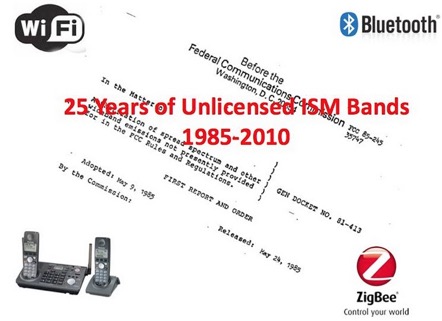Where Did Wi-Fi and Bluetooth Come From? Part 1

May 9th will be the 25th anniversary of the Report and Order in Docket 81-413 that created the regulatory basis for Wi-Fi, Bluetooth, and a variety of other lesser known products. While many people think it is the origin of unlicensed systems, unlicensed has been allowed since the late 1930s but under restrictive rules that allowed a certain frequencies to be used for narrowly restricted applications in response to industry requests. What set the May 1985 decision apart was the lack of restrictions on use, interference focused technical regulations, and more generous transmitter power than previously allowed.
Your blogger would love to be able to document that in the early 1980s he foresaw the need for wireless LANs and thus planned the rules or this application. In the early 1980s LAN technology was known to techies, Bob Metcalfe was an MIT classmate. But there was no general consensus that LANs would ever be widespread or that RLANs were needed.
As has been said previously, technology moves at “Internet speed” and governments move at “government speed”. Thus it would have been impossible to directly anticipate such a need. Several years later the European Union did anticipate the RLAN need and tried to address it with its GSM-like consensus standards process. The result was HiperLAN which never had much impact.

Central to what I brought to the commission was the idea of continual innovation, new ways to meet practical needs. The need relevant to this discussion concerns the FCC and its then Chairman, Charlie Ferris. Charlie went to the FCC in October 1977. On 23 March 1978 an evolving concept of regulation was formalized in Executive Order 12044, ‘‘Improving Government Regulations.’’ It said the President wished ‘‘Regulations shall be as simple and clear as possible. They shall achieve legislative goals effectively and efficiently. They shall not impose unnecessary burdens on the economy, on individuals, on public or private organizations, or on State and local governments.’’ The Executive Order further instructed regulatory agencies to review existing regulations on the basis of criteria that included ‘‘the continued need for the regulation,’’ and ‘‘the length of time since the regulation had been evaluated or the degree to which technology, economic conditions or other factors have changed in the area affected by the regulation’’.
Former FCC Chairman Ferris

Within a few days I responded with a short list: spread spectrum, millimeter wave, and smart antennas. That turned out to be my ticket out of the military-industrial complex and within 4 months I was on the FCC payroll. Further review of the options lead to the conclusion that spread spectrum should be the initial goal in executing the EO 12044 strategy. We contracted with MITRE Corp., a Pentagon think tank focusing on communications and radar issues, to review the policy options and they produced a thought provoking report. This report raised the issue of spread spectrum in the ISM band for the first time. (It is interesting to note that since 1980 FCC has never contracted for a similar report on technical policy options unless ordered by Congress. In retrospect, the $55,652 spent on that report was probably the best investment FCC had ever made!)
Formal regulatory action was no underway when the Reagan Transition came, but despite all the partisan rhetoric, this type of deregulation was one area where Carter partisans and Reaganites were in agreement.
Thus the FCC under Chmn. Fowler adopted the NOI in Docket 81-413 on June 30, 1981.



![Validate my RSS feed [Valid RSS]](valid-rss-rogers.png)

